Physiotherapy unit
Currently, the use of physiotherapy methods in the treatment and rehabilitation of patients with various diseases makes it possible to significantly improve the clinical condition of patients, to obtain pronounced analgesic, anti-inflammatory, anti-edema and anti-stress effects, with physiotherapy methods being combined with medication therapy, exercise therapy and massages. Numerous research efforts have confirmed that the inclusion of physiotherapy methods in rehabilitation and treatment complexes significantly increases their effectiveness. In addition, wellness programmes have been developed using various physiotherapy methods to boost immunity, relieve fatigue, and improve physical and mental performance.
In FSBI “NMRC RB” of the Ministry of Health of Russia offers modern, highly effective physiotherapy procedures:
Extracorporeal shock-wave therapy
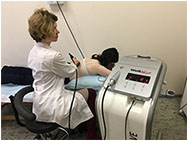 In clinical practice, physiotherapeutic techniques with pronounced analgesic, anti-inflammatory and regenerative effects are in demand. Extracorporeal shockwave therapy (EST) can be fully classified as one of these innovative technologies. Its use in the treatment and rehabilitation of patients with musculoskeletal and neurological diseases and injuries is most justified, since it is for this category of patients that the greatest number of research efforts has been made, proving its high effectiveness. Extracorporeal shockwave therapy is characterized by an early analgesic effect with a small number of treatment procedures (up to 4-6 per course), even for chronic pain syndromes. EST not only reduces pain, but also significantly increases circulation and metabolic processes in the affected area.
In clinical practice, physiotherapeutic techniques with pronounced analgesic, anti-inflammatory and regenerative effects are in demand. Extracorporeal shockwave therapy (EST) can be fully classified as one of these innovative technologies. Its use in the treatment and rehabilitation of patients with musculoskeletal and neurological diseases and injuries is most justified, since it is for this category of patients that the greatest number of research efforts has been made, proving its high effectiveness. Extracorporeal shockwave therapy is characterized by an early analgesic effect with a small number of treatment procedures (up to 4-6 per course), even for chronic pain syndromes. EST not only reduces pain, but also significantly increases circulation and metabolic processes in the affected area.
High-intensity laser therapy (HILT)
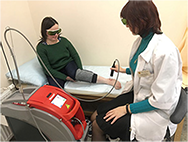 High-intensity laser therapy is a method of treatment using high-intensity laser radiation. It has a pronounced analgesic and trophic-regenerative effect, significantly improves blood circulation and metabolic processes and has an anti-inflammatory effect in cases of diseases of the nervous system and the musculoskeletal system. High-intensity laser therapy is most effective for degenerative diseases of the joints and spine that are accompanied by severe pain.
High-intensity laser therapy is a method of treatment using high-intensity laser radiation. It has a pronounced analgesic and trophic-regenerative effect, significantly improves blood circulation and metabolic processes and has an anti-inflammatory effect in cases of diseases of the nervous system and the musculoskeletal system. High-intensity laser therapy is most effective for degenerative diseases of the joints and spine that are accompanied by severe pain.
Low-intensity laser therapy
Low-intensity laser therapy has been widely used in clinical practice for more than 30 years. FSBI “NMRC RB” has developed unique treatment methods for patients with atherosclerosis of lower limb vessels, hypertension, coronary heart disease, neuritis of the facial nerve, cerebral circulatory disorders, osteochondrosis and osteoarthritis, gynaecological and urological diseases, etc.
The anti-inflammatory, regenerative, immunocorrective, anti-stressor effects of the laser therapy and its pronounced positive effect on the state of blood circulation and metabolic processes have been proved. In patients with reduced immunity, frequent exacerbations of chronic diseases in the physiotherapy unit offers highly effective procedures of supravascular laser irradiation of the blood.
Local air cryotherapy
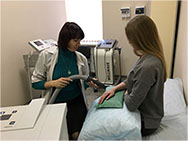 Cryotherapy is the treatment of organs and tissues with cold factors that reduce the temperature of tissues to the limits of their cryoresistance. The use of cold has a long history, for example, the use of ice and snow for therapeutic purposes is mentioned in the works of Hippocrates (460-377 BC).
Cryotherapy is the treatment of organs and tissues with cold factors that reduce the temperature of tissues to the limits of their cryoresistance. The use of cold has a long history, for example, the use of ice and snow for therapeutic purposes is mentioned in the works of Hippocrates (460-377 BC).
Cryotherapy has various therapeutic effects, such as pain relief, improvement of microcirculation and tissue regeneration, reduction of edema and inflammation, stimulation of metabolism. In recent decades, devices for local cryotherapy with a cold air jet at -40°C to -60°C have become the most widespread. Air cryotherapy procedures are physiological, painless, safe, short-term (2-10 min) and highly effective.
General cryotherapy
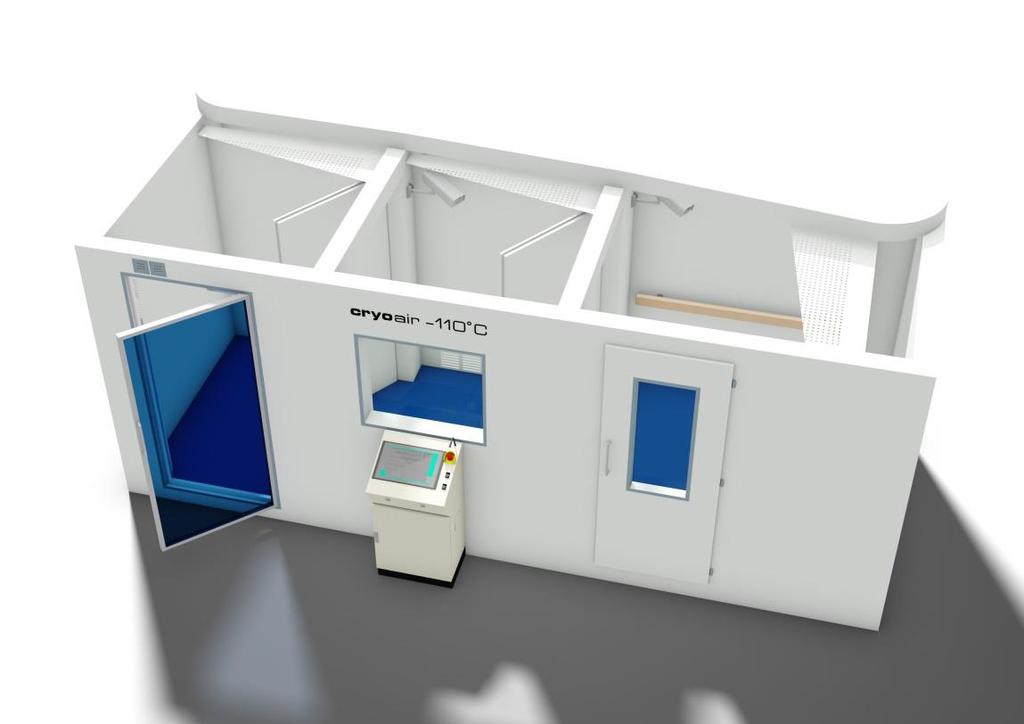 At the end of the 1970s, the Japanese scientist T. Yamauchi, who developed the first cryochambers, substantiated and proved in practice the effectiveness of general short-term exposure to extreme cold at 160 - 180 degrees for rheumatic arthritis. General cryotherapy causes a decrease in tissue temperature, a sharp decrease in nerve conduction, which manifests itself in a high analgesic effect. General cryotherapy improves the psycho-emotional state of patients: already, after the first procedure, there is an improvement in mood, a feeling of freshness, lightness, a decrease in depression and emotional tension. In evolutionary terms, man has never encountered such low temperatures and it mobilizes the body to react with all adaptation mechanisms, including the immune, endocrine and other essential systems. At the same time, the harmonization of the activities of the whole body persists after one course (10-12 procedures) for at least 6 months.
At the end of the 1970s, the Japanese scientist T. Yamauchi, who developed the first cryochambers, substantiated and proved in practice the effectiveness of general short-term exposure to extreme cold at 160 - 180 degrees for rheumatic arthritis. General cryotherapy causes a decrease in tissue temperature, a sharp decrease in nerve conduction, which manifests itself in a high analgesic effect. General cryotherapy improves the psycho-emotional state of patients: already, after the first procedure, there is an improvement in mood, a feeling of freshness, lightness, a decrease in depression and emotional tension. In evolutionary terms, man has never encountered such low temperatures and it mobilizes the body to react with all adaptation mechanisms, including the immune, endocrine and other essential systems. At the same time, the harmonization of the activities of the whole body persists after one course (10-12 procedures) for at least 6 months.
General cryotherapy in FSBI "NMRC RB" is carried out in a modern air-conditioned three-stage cryosauna.
Low-frequency pulsed electromagnetic field
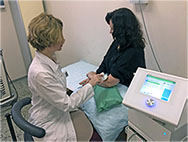 Low-frequency pulsed electromagnetic field (LFPEF), also known as electrostatic massage, is a unique therapeutic technique based on the exposure of the human skin to an alternating electrostatic field between the therapist's hands or a hand-held applicator and the patient's body surface. The patient's tissues are electrostatically attracted and released at a preset frequency (5-200Hz). The electrostatic pulses create pleasant, deeply penetrating vibrations that affect the skin, connective tissue, subcutaneous fatty tissue, lymphatic and venous vessels. These vibrations have a targeted trophic-stimulating, anti-inflammatory, analgesic and draining effect, eliminating edema and increasing the muscle activity.
Low-frequency pulsed electromagnetic field (LFPEF), also known as electrostatic massage, is a unique therapeutic technique based on the exposure of the human skin to an alternating electrostatic field between the therapist's hands or a hand-held applicator and the patient's body surface. The patient's tissues are electrostatically attracted and released at a preset frequency (5-200Hz). The electrostatic pulses create pleasant, deeply penetrating vibrations that affect the skin, connective tissue, subcutaneous fatty tissue, lymphatic and venous vessels. These vibrations have a targeted trophic-stimulating, anti-inflammatory, analgesic and draining effect, eliminating edema and increasing the muscle activity.
General magnetotherapy
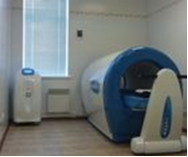 The magnetoturbotron is a rotating magnetic field unit with the possibility to change its frequency, induction, direction of rotation. The action of the unit is to create vortex fields in the human body, allowing all the organism's systems to be affected simultaneously, including the nervous, endocrine, cardiovascular and lymphatic systems, as well as metabolism and redox processes, etc. General magnetotherapy is effective for hypertension, bronchial asthma and psycho-emotional stress. A wide range of indications for treatment and versatility of action on the body, as well as a limited number of contraindications allows the use of the device for general magnetotherapy not only in the treatment of diseases, but also in the rehabilitation of patients, as well as for preventive purposes for almost healthy people.
The magnetoturbotron is a rotating magnetic field unit with the possibility to change its frequency, induction, direction of rotation. The action of the unit is to create vortex fields in the human body, allowing all the organism's systems to be affected simultaneously, including the nervous, endocrine, cardiovascular and lymphatic systems, as well as metabolism and redox processes, etc. General magnetotherapy is effective for hypertension, bronchial asthma and psycho-emotional stress. A wide range of indications for treatment and versatility of action on the body, as well as a limited number of contraindications allows the use of the device for general magnetotherapy not only in the treatment of diseases, but also in the rehabilitation of patients, as well as for preventive purposes for almost healthy people.
Instrumental physiotherapy
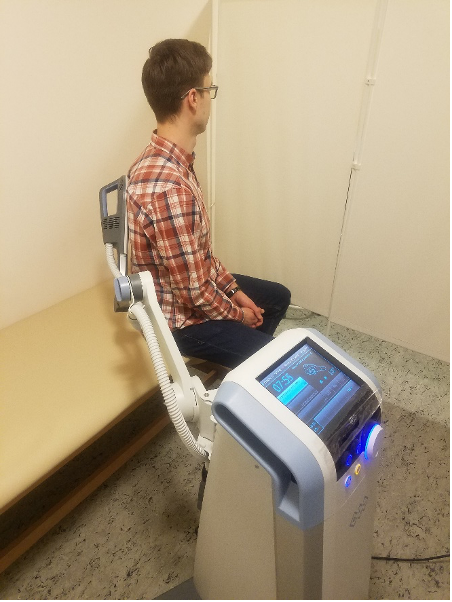
BTL-6000 Super Inductive System high-intensity magnetotherapy unit for magnetic stimulation
Magnetic stimulation is a modern, painless method of stimulating the neuromuscular system, based on the multifactorial action of a high-intensity magnetic field on human tissue. This procedure not only strengthens muscles and increases exercise tolerance, but also eliminates pain, relieves muscle tension, edema and spasm, accelerates healing of fractures, increases joint mobility, improves breathing after pneumonia and is a preventive measure against muscle atrophy. Excellent results have been achieved in the rehabilitation of diseases of the neuromuscular system and the musculoskeletal system, accompanied by pain syndromes, in patients after pneumonia caused by the new coronavirus infection COVID-19.
BTL-6000 Super Inductive System EMSELLA high intensity magnetotherapy unit for pelvic floor muscles magnetostimulation
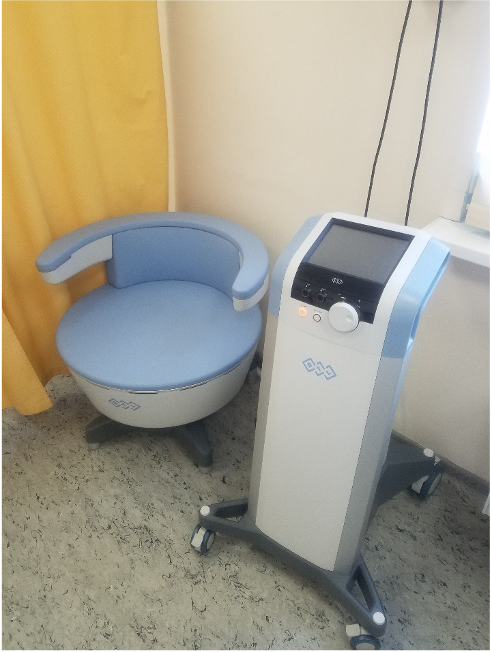 BTL-6000 Super Inductive System EMSELLA high intensity magnetotherapy unit for magnetostimulation of pelvic floor muscles and pelvic organs. Magnetic stimulation causes contraction of the pelvic floor muscles, the colon, the vagina, the uterus, the bladder, the urethral sphincter and the prostate, with a subsequent relaxation. Changing the various modes during the procedure provides not only a muscle workout, but also an improvement in microcirculation, trophism and the normalization of the complex neurological component of the regulation of the pelvic organs. This procedure is recommended for both men and women. For women it is a way to solve delicate problems caused by weakened pelvic floor muscles, pelvic organ prolapse in the form of urinary incontinence, sexual dysfunction, which is a complication of frequent and difficult deliveries, involuntary age processes, onset of menopause, injuries, and operations.
For men, it is a training of the pelvic floor muscles, the muscles that regulate the filling of the erectile tissues and the muscles that regulate the ejaculation rate. The result is an increased erection and the ability to regulate the duration of a sexual intercourse.
BTL-6000 Super Inductive System EMSELLA high intensity magnetotherapy unit for magnetostimulation of pelvic floor muscles and pelvic organs. Magnetic stimulation causes contraction of the pelvic floor muscles, the colon, the vagina, the uterus, the bladder, the urethral sphincter and the prostate, with a subsequent relaxation. Changing the various modes during the procedure provides not only a muscle workout, but also an improvement in microcirculation, trophism and the normalization of the complex neurological component of the regulation of the pelvic organs. This procedure is recommended for both men and women. For women it is a way to solve delicate problems caused by weakened pelvic floor muscles, pelvic organ prolapse in the form of urinary incontinence, sexual dysfunction, which is a complication of frequent and difficult deliveries, involuntary age processes, onset of menopause, injuries, and operations.
For men, it is a training of the pelvic floor muscles, the muscles that regulate the filling of the erectile tissues and the muscles that regulate the ejaculation rate. The result is an increased erection and the ability to regulate the duration of a sexual intercourse.
An important advantage is that you can receive the magnetotherapy treatment with your clothes on.
The availability of imported devices of combined action in the physiotherapy unit makes it possible to carry out simultaneous (combined) electro-ultrasound and vacuum-interference therapy, which significantly increases the effectiveness of the treatment of many inflammatory and dystrophic diseases.
In addition, the unit has equipment for all traditional physiotherapy procedures: electrotherapy (amplipulse therapy, interference therapy, diadynamic therapy, ultraton therapy, darsonvalisation, neurotropic electrotherapy), magnetic therapy, ultrasound therapy, photochromotherapy, ultrahigh frequency (UHF), superhigh frequency (UHF and SHF) and structural resonance therapy, etc.
The physiotherapy unit performs advanced electrodiagnostics to determine the degree of neuromuscular excitability, on the basis of which manual electrostimulation in patients with various neurological disorders is carried out. The procedures are carried out by Kubalova M.N., PhD (Medicine).
The physiotherapy unit consists of highly qualified physiotherapists, including PhDs and holders of Habilitation degree in Medicine.
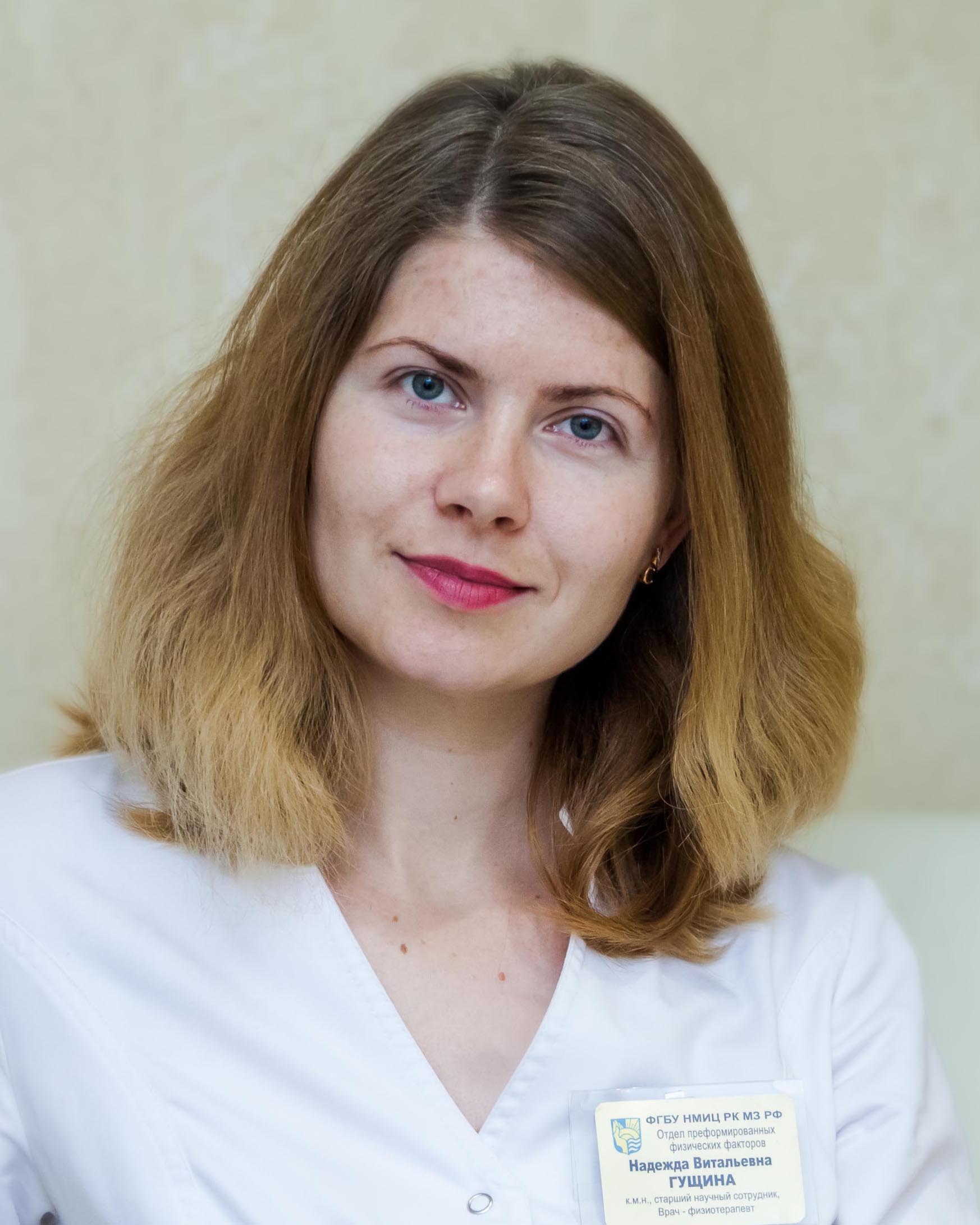
GUSHCHINA NADEZHDA VITALIYEVNA
Head of the medical rehabilitation department, PhD (Medicine), physiotherapist.
Over 15 years' experience in physiotherapy.
Proficient in all modern methods of physiotherapy.
